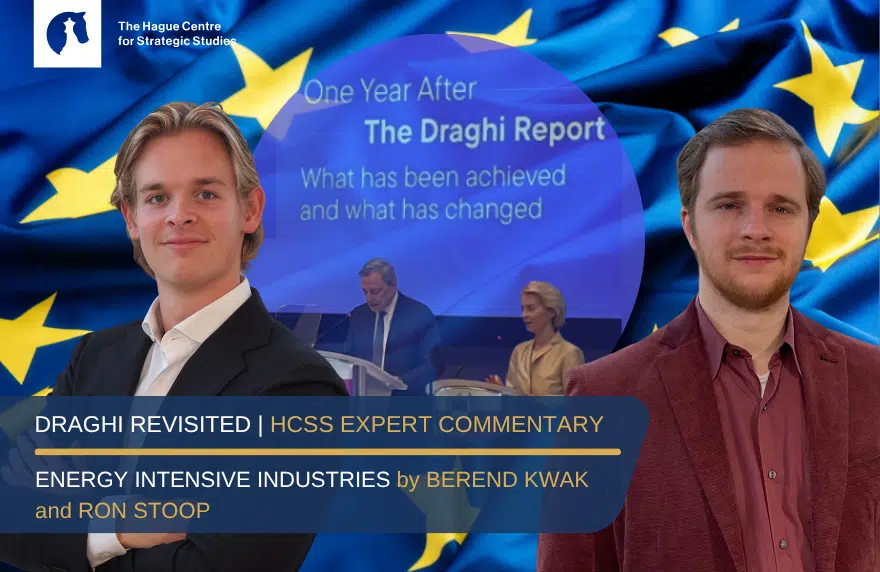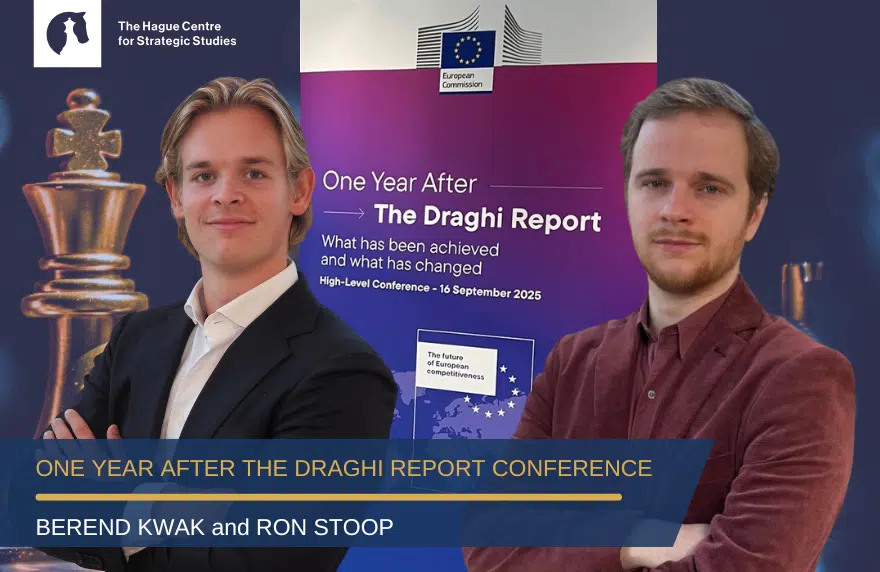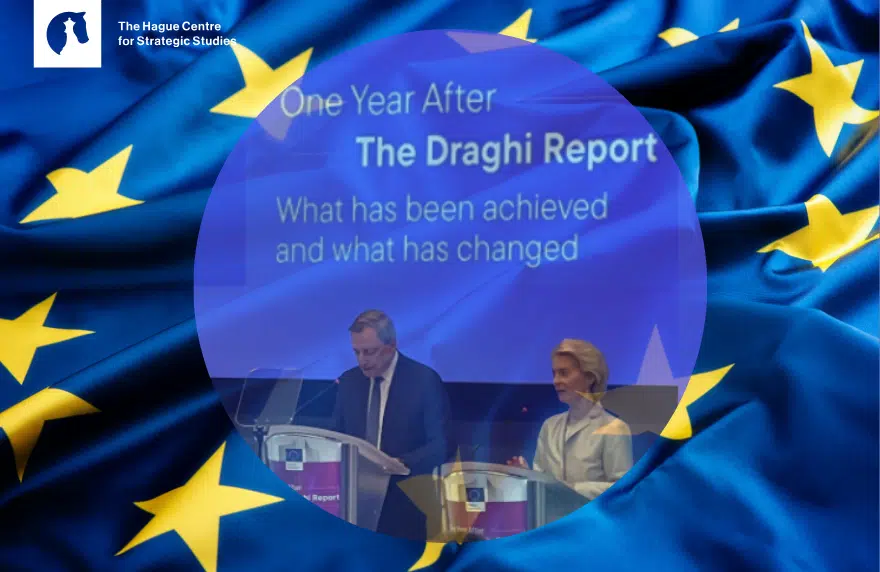One year after Mario Draghi’s landmark report on Europe’s economic future, HCSS launches the second edition of its Draghi Report Series.
Despite political attention, Europe still struggles with dependencies in defence, raw materials, cleantech, and digital domains. Global tensions with both China and the US are mounting, and Europe’s trade model faces unprecedented pressure. Progress has been uneven and often too slow due to coordination, financing and other internal barriers.
Last year, Ron Stoop and Berend Kwak examined the long-term implications of Draghi’s recommendations in a series of interviews with our experts. Now, they return to assess how far Europe has come in addressing his urgent call to secure industrial, technological and economic sovereignty, with HCSS analysts revisiting Draghi’s warnings sector by sector.
For the seventh article of our Draghi Revisited series, strategic analysts Ron Stoop and Berend Kwak focus on Energy-Intensive Industries (EII): what steps has the EU taken to protect and decarbonise its most critical industrial sectors?
Since the Draghi Report, what concrete steps have been taken – and how effective have they been so far?
Ron Stoop: Since the Draghi Report, the EU has started several reforms and initiatives. The Carbon Border Adjustment Mechanism (CBAM), that should protect Energy Intensive Industries (EIIs) from foreign carbon-intensive imports, was further prepared for implementation in 2026. Early 2025, The Clean Industrial Deal was introduced to help energy-intensive industries cut costs, deploy clean technologies, and stay competitive against cheaper imports. Moreover, sector-specific protectionist measures have been implemented, such as steel import agreements establishing long-term quotas and higher tariffs. Energy pricing policy has also proliferated in several member states. In Germany, France and Italy, public funds have been directed into initiatives to stabilize power prices for large consumers. While these measures have stabilized electricity prices, EU industrial power prices still stand at twice the US level. Chinese imports continue to undermine European producer margins, and major investment decisions in green steel and chemicals remain delayed by ongoing uncertainty and insufficient renewable energy infrastructure.
Berend Kwak: Brussels has been setting up new frameworks to try and nurture and protect EIIs in Europe. A landmark development was the Clean Industrial Deal (CID), launched in February 2025. This initiative supports Draghi’s recommendations by explicitly creating a link between competitiveness and decarbonisation. As part of the CID, the Industrial Decarbonisation Accelerator Act (IDAA) was announced, which is expected later this year. This act is supposed to simplify permitting and improve security, both strong necessities for European industrial development and innovation. Additionally, the CID should unlock roughly €100 billion in clean-industry investment. Increased power purchase agreements (PPAs) and contracts for difference should improve energy cost conditions, as these long-term contracts could stabilise electricity costs for EIIs. This is much needed as power prices remain the most direct barrier to decarbonisation (next to permitting speed). In March 2025, the EU adopted a Steel & Metals Action Plan and launched the first review of the Carbon Border Adjustment Mechanism (CBAM), both initiatives geared towards supporting and safeguarding local EII production during a precarious phase of the energy transition. And support is needed: several flagship decarbonisation projects in Sweden and Germany have been delayed or scaled back, as companies like Salzgitter, ArcelorMittal and Thyssenkrupp suspend or delay expansions. Shell cancelled its biofuel plant development in Rotterdam. These decisions boil down to economics: costs are too high, and demand for sustainable heavy industry output is too low to be competitive with foreign suppliers or conventional energy sources. In the current setup, EIIs lack the necessary conditions for rapid decarbonisation.
Where do the biggest gaps lie between ambition and implementation – and why?
Ron Stoop: The main gap lies between political ambition and market realities. The EU has created a rulebook for (state supported or -facilitated) long-term energy contracts, yet few long-term industrial power contracts have been signed because of lack of state guarantees and public budget constraints. Industrial power costs remain structurally high, with Italy around €100/MWh and Germany at €80/MWh. This makes competing in the global marketplace increasingly hard. Decarbonisation initiatives face lagging infrastructure investments, lack of feedstock and large cost differentials vis-à-vis traditional production methods. Projects in cement and lime lack access to carbon storage, delaying final investment decisions. Hydrogen infrastructure is advancing slowly. The gas and hydrogen costs still differ significantly between member states. CBAM and trade protection measures exist but fall short to fully shield European EIIs against the large global market shocks. Subsidized Chinese products such as steel, aluminium and cement are obliterating European profit margins, forcing production cutbacks or outright closures. State-aid remains fragmented, permitting is complex, and coordination between the Commission and national regulators is suboptimal. In short, Europe has a policy roadmap but trails in execution, capital mobilisation, and implementation speed.
Berend Kwak: The EU is improving on coordination but has a lot of work to do to close gaps to implementation. Industrial power prices remain more expensive and volatile than in other regions. In addition, demand is still low for sustainable EII-products. Those two factors alone explain much of the hesitation around clean steel, chemicals, and other large-scale decarbonisation projects. In addition, infrastructure is still a serious challenge. Connections to the grid and overall grid capacity are too limited. Investments need to happen across the value chain and move at the same time to avoid coordination failures. This means that subsidy coordination across EU member states should be improved. Shorter: Member states spend billions on industrial state aid through largely uncoordinated national programmes. A coordinated Union-wide approach would better serve Draghi’s competitiveness agenda. As Von der Leyen and Draghi emphasized at their September 2025 High-Level Conference, national schemes must be integrated into a coherent EU industrial strategy.
What should be the EU’s top priorities – and where to scale back?
Ron Stoop: The top priority is to lower and stabilise industrial power prices. Member states should support initiatives (such as long term pricing agreements and energy and infrastructure investment) to reach stable power prices around €50–70 MWh, ideally more towards the lower end of that spectrum to stay globally competitive. Second, Europe must build the required infrastructure for a decarbonised local heavy industry. Third, sectoral protection mechanisms (such as for steel) should be upheld and linked to decarbonisation targets. The EU should also pool funds into EU-wide decarbonisation infrastructure (e.g. circular supply chains, CO2 storage, adequate power grids). The implementation of CBAM remains a huge priority, since both its complexity and (unintended) side-effects warrant the closest possible scrutiny. This way, negative consequences for European producers can be mitigated before they damage the European industrial fabric.
Berend Kwak: First, close the energy-price gap by accelerating grid development, reforming energy taxation, and expanding renewable incentives for industry. Second, strengthen CBAM by extending it to downstream sectors and addressing “dirty” imports from cheaper suppliers. Third, ensure vertical implementation by translating existing frameworks into practical, long-term industry expectations. The US demonstrates this approach through the IRA and CHIPS Act, which have successfully driven investment and competitiveness.
If we meet again next year, what measurable outcome would convince you Europe’s on track – and why?
Ron Stoop: If the EU can overcome fragmentation and slow implementation by pooling resources and streamlining regulation to create a unified strategic framework, it would be on the right track.
Berend Kwak: I would look for a significant increase in renewable PPAs, which would support both the rollout of renewable energy and the increase of sustainable industrial output.








